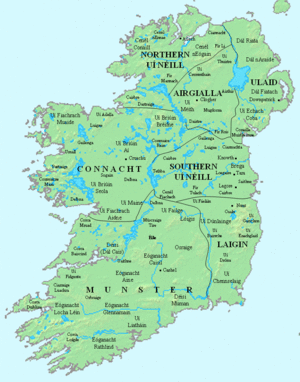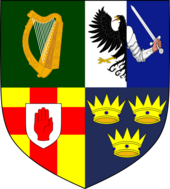Provinces of Ireland facts for kids
The four provinces of Ireland are Connacht, Leinster, Munster, and Ulster. Even though they don't have a political or administrative role today, they are very important for Ireland's history and culture. The Irish word for province is cúige, which means "fifth part." This suggests there might have been five provinces long ago. Sometimes, Meath was even considered the fifth province. The number and borders of these provinces changed a lot until 1610. That's when the English government under King James I officially set them.
Quick facts for kids Irish provinces |
|
|---|---|
| Location | Ireland |
| Number | 4 |
| Populations | 589,338 (Connacht) 2,870,354 (Leinster) 1,373,346 (Munster) 2,217,176 (Ulster) |
| Subdivisions | Counties |
Contents
What Does 'Cúige' Mean?
In modern Irish, the word for province is cúige. It comes from the older Irish word cóiced, which literally meant "a fifth." This word was used in old texts from the 8th century and in famous stories like the Ulster Cycle. In these stories, it referred to the five kingdoms of the "Pentarchy."
Historians believe the first five "fifths" were the kingdoms of Ulster, Connacht, Munster, and two parts of Leinster (North Leinster and South Leinster). Over time, the word cúige simply came to mean "province," losing its original meaning of "a fifth."
A Look at Their History
The provinces of Ireland started as medieval "over-kingdoms" called cóiceda. Even though the idea was that there were five, in reality, there were often more. Around the 9th century, there were seven main over-kingdoms: Airgíalla, Connachta, Laigin, Northern Uí Néill, Southern Uí Néill, Mumu, and Ulaid. These seven were still listed in a 12th-century book called Lebor na Cert.
How Kingdoms Were Organized
In early medieval times, these over-kingdoms had a structured system:
- A province was led by a "king of over-kings," called a rí ruírech. Later, this title changed to rí cóicid, meaning "king of a fifth" or "king of a province."
- Each province was made up of several smaller kingdoms. These were similar in size to today's Irish counties. They were ruled by an overking called a ruirí.
- These smaller kingdoms were then divided into even smaller areas called a túath. A túath was a group of people, roughly the size of an Irish barony. They were ruled by a king, or rí túaithe. By the 10th century, these rulers were often called "lords" (tigern) or "leaders" (toísech) instead of kings.
Changes in the Medieval Period
The kingdom of Osraige was part of Munster for a while, but it became independent in 859. It then slowly became more connected to Leinster.
In 1118, the kingdom of Munster was split into two parts: Tuadmumu (North Munster, also called Thomond) and Desmumu (South Munster, also called Desmond). This happened because of a rebellion and power struggles between different ruling families.
Norman Influence
After the Norman invasion of Ireland in 1170, some Irish kingdoms were taken over. Osraige was one of the first to fall. The Normans then created "liberties" (areas they controlled) based on the old kingdoms. These liberties later became the basis for the counties.
The Northern Uí Néill in Ulster mostly stayed outside Norman control. They eventually took over much of Airgíalla. By the 14th century, after the Normans lost some power, the O'Neills of Tyrone claimed the title "king of Ulster." This brought their territory together into one united province. At this point, the number of provinces was reduced to five: Connacht, Leinster, Meath, Munster, and Ulster.
Tudor Era Changes

During the reigns of Queen Mary I and Queen Elizabeth I, there were plans to divide Ireland differently, but these plans were never fully carried out.
The borders of the provinces changed several times as new counties were created:
- County Clare was moved from Munster to Connacht in 1569, but it returned to Munster after 1660.
- County Longford moved from Leinster to Connacht in 1583.
- County Cavan moved from Connacht to Ulster in 1584.
- County Louth moved from Ulster to Leinster.
It wasn't until King James I's reign, around 1610, that Meath stopped being considered a province, and the borders of the four main provinces were finally set permanently.
Ancient Origins
The earliest stories about Ireland's main divisions come from the Ulster Cycle of legends, like the famous Táin Bó Cúailnge (The Cattle Raid of Cooley). These legends are thought to be from the 1st century. They describe Ireland as being divided into five independent over-kingdoms, or cuigeadh, whose kings were all equal. This time was called the "Time of the Pentarchs" or "Time of the Five Fifths."
The five provinces of this ancient Pentarchy were:
- Connacht, with its royal seat at Cruachan.
- Ulaid (Ulster), with its royal seat at Emain Macha.
- Muman (Munster), with its royal seat at Teamhair Erann.
- Laigen Tuathgabair (North Leinster), with its royal seat at Tara.
- Laigen Desgabair (South Leinster), with its royal seat at Dinn Riogh.
Historians believe this division into five parts is very old, even from before the Gaels arrived in Ireland. Even though these specific five divisions didn't exist by the 5th century, the idea of Ireland being divided into five parts stayed strong in Irish stories for many centuries.
The Three Collas and Airgíalla
The myth of the Three Collas tells a story from the late 4th or early 5th century. The Three Collas—Colla Menn, Colla Da Crioch, and Colla Uais—were brothers. Their descendants are said to be the Airgíalla people.
According to the story, the Collas were told by the High King of Ireland to conquer their own land. They fought seven battles against the Ulaid people in southern Ulster. After the last battle, the king of Ulaid was killed, and his army was defeated. The Collas then burned the Ulaid capital, Emain Macha, and took control of central Ulster. This is how the over-kingdom of Airgíalla was founded.
How Provinces Are Used Today
Today, the provinces are mostly used for cultural and historical reasons. They don't have any legal power. You'll often see them in sports:
- Ireland's four professional rugby teams in the United Rugby Championship play under the names of the provinces.
- The Gaelic Athletic Association (GAA) has separate provincial councils. Its county teams compete in provincial championships.
Six of the nine counties in Ulster form modern-day Northern Ireland, which is part of the United Kingdom. Many political parties and media outlets there use "Ulster" in their names, like the Ulster Unionist Party and Ulster Television.
In education, universities like Munster Technological University and Ulster University use the names of their provinces. Many hotels and local newspapers also use province names.
The idea of the four provinces was also part of a political proposal called Éire Nua ("New Ireland") in the 1970s and 1980s. This plan suggested a united Ireland with separate assemblies for each of the four historic provinces.
The song Ireland's Call is used as an anthem for sports teams representing the whole island, like the Ireland national rugby union team. The first verse mentions "the four proud provinces of Ireland."
Provincial Coats of Arms
Each province has its own unique coat of arms and flag. These are often combined to represent all-Ireland sports teams and organizations. For example, the Four Provinces Flag of Ireland and a four-province crest are used by teams like the Ireland men's national field hockey team and the Ireland national rugby union team.
Poetic Descriptions
Ard Ruide Poem

An old poem called Ard Ruide (Ruide Headland) beautifully describes the five ancient kingdoms of Ireland:
Connacht in the west is the kingdom of learning, home to the wisest druids and magicians. The people of Connacht are known for their good speaking skills, their good looks, and their fair judgments.
Ulster in the north is the place of brave battles, pride, and boasting. The men of Ulster are the fiercest warriors in all Ireland. The queens and goddesses of Ulster are linked to battle and death.
Leinster, the eastern kingdom, is known for wealth, hospitality, and importing fancy goods like silk and wine. The men of Leinster speak nobly, and their women are very beautiful.
Munster in the south is the kingdom of music and arts, with many harpers, skilled board game players, and horsemen. The fairs in Munster were the biggest in Ireland.
The last kingdom, Meath, is the kingdom of Kingship and good leadership. In Meath is the Hill of Tara, the traditional home of the High King of Ireland. The old earthwork at Tara is called Rath na Ríthe ('Ringfort of the Kings').
The Táin Epic Poem
The epic poem, An Táin Bó Cúailnge (The Cattle Raid of Cooley), tells the story of a war between Connacht and Ulster. It's famous for Cú Chulainn's amazing solo defense of Ulster against the champions of Connacht. He fought them one by one while his friends were unable to fight because of a spell.
See also
 In Spanish: Provincias de Irlanda para niños
In Spanish: Provincias de Irlanda para niños




